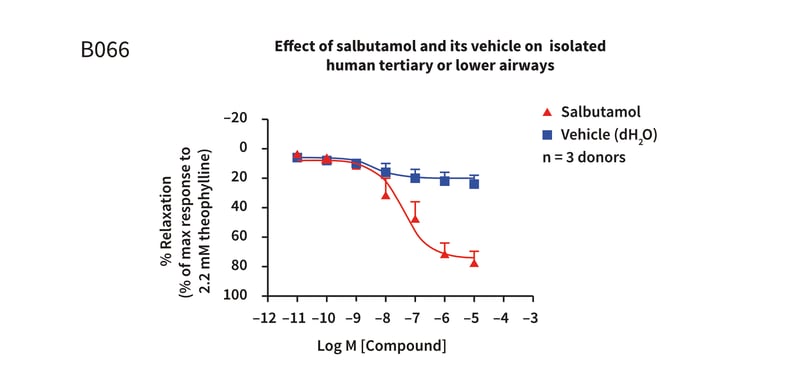Bronchodilatation in tertiary or lower human airways (Adrenoceptors – Salbutamol)
Drug Discovery Assay – reference number: B066
Overview
| Assay type: | Respiratory |
| Tissue: | Human tertiary or lower airways (healthy) |
| Target: | Adrenoceptors |
| Control compound: | Salbutamol |
| Study type: | Wire myography |
| Functional endpoint: | Bronchodilatation |
Assay Description
This assay assesses whether test compounds cause bronchodilation in human airways with salbutamol as a reference compound.
The airways of the respiratory tract offer resistance to the flow of air during inhalation and expiration. Any alterations to the airways (for example contractile state, increased mucus or inflammation of the airways) can affect airflow and gas exchange.
 Figure 1: Cumulative concentration response curve to salbutamol and its vehicle in isolated human airways pre-constricted with 1 × 10−5M carbachol, demonstrating a concentration dependent relaxation response in the presence salbutamol. The Log EC50 = −7.44 ± 0.25M (36.2nM) (mean ± S.E.M), with a maximum response of 77.91 ± 11.74% compared to a maximum response of 23.26 ± 2.64% for the vehicle.
Figure 1: Cumulative concentration response curve to salbutamol and its vehicle in isolated human airways pre-constricted with 1 × 10−5M carbachol, demonstrating a concentration dependent relaxation response in the presence salbutamol. The Log EC50 = −7.44 ± 0.25M (36.2nM) (mean ± S.E.M), with a maximum response of 77.91 ± 11.74% compared to a maximum response of 23.26 ± 2.64% for the vehicle.
Testing Information
Introduction
The specific results that will be provided are the effects of increasing concentrations of test articles on the contractile state of isolated human airways.
Test Article Requirements
Test article(s) to be provided by the Sponsor in storable aliquots at required test concentrations with information on diluent vehicle used. Stock solutions are prepared in distilled water unless otherwise requested. Bath volumes are 5mL; sponsor to provide sufficient test article to run the entire study.
Suggested Testing
In duplicate at 6 concentrations.
Study Outline
Rationale and Experimental Design
This assay assesses whether test compounds cause bronchodilation in human airways with salbutamol as a reference compound.
Exclusion Criteria
No specific exclusion criteria are in place other than to reject macroscopically diseased/necrotic tissue. Furthermore, tissues which do not respond to the standard pharmacology checks will be excluded.
Standardisation and Qualification
All individual airways are initially processed through standardisation and qualification procedures to ensure functionality, prior to starting the study protocol.
Airways are processed through a standardisation procedure to reduce signal variability prior to pharmacological intervention. This ensures that airways are maintained under appropriate physiological tension throughout the experiments.
Following standardisation, the airways are challenged with an appropriate bronchoconstrictive agent to ensure robust contractile responses.
Test tissues are then washed, and the responses allowed to return to baseline.
Airways which pass the standardisation and qualification pass/fail criteria will then progress to the study protocol.
Bronchodilatation Assays
Agonist Bronchodilatation Assays
To assess the ability of each test article to elicit bronchodilatation, 6 point cumulative concentration response curves (CCRC’s) will be performed for each test article. These CCRC’s will be performed following pre-constriction with an appropriate bronchoconstrictive agent. A positive control compound and representative test article vehicle CCRC will also be run to allow direct comparison with test articles.
An example of the conditions assessed for 3 test articles are detailed below (each condition will be run in duplicate airways):
-
Representative test article vehicle CCRC
-
Test article 1 CCRC
-
Test article 2 CCRC
-
Test article 3 CCRC
-
Positive control CCRC
Supplementary Option
To assess the involvement of a specific receptor subtype in any observed responses, the concentration of test article eliciting the largest response can subsequently (following a wash out and recovery period) be tested in the presence of a specific antagonist. This supplementary option will incur an extra charge.
Antagonist Bronchodilatation Assays
Option 1 − IC50 Determination
To assess the ability of each test article to antagonise an agonist mediated bronchorelaxation response, 6 point cumulative concentration response curves (CCRC’s) will be performed for each test article. These CCRC’s will be performed following pre-constriction and relaxation with an appropriate bronchorelaxant reference agonist. A positive control compound and representative test article vehicle CCRC will also be run to allow direct comparison with test articles.
An example of the conditions assessed for 3 test articles are detailed below (each condition will be run in duplicate airways):
-
Representative test article vehicle CCRC
-
Test article 1 CCRC
-
Test article 2 CCRC
-
Test article 3 CCRC
-
Positive control CCRC
Option 2 − pA2 Determination
To assess the ability of a test article to antagonise an agonist mediated bronchorelaxation response; 6 point cumulative concentration response curves (CCRC’s) will firstly be performed for the reference agonist, following pre-constriction with an appropriate bronchoconstrictive agent. Following a wash out and recovery period, vessels will be incubated with the test article (3 different concentrations of test article will be assessed), positive control or test article vehicle before the same 6 point cumulative concentration response curve will be repeated for the reference agonist.
An example of the conditions assessed for 3 test articles are detailed below (each condition will be run in duplicate airways):
-
Representative test article vehicle
-
Test article 1 concentration 1
-
Test article 1 concentration 2
-
Test article 1 concentration 3
-
Test article 2 concentration 1
-
Test article 2 concentration 2
-
Test article 2 concentration 3
-
Test article 3 concentration 1
-
Test article 3 concentration 2
-
Test article 3 concentration 3
-
Positive control
Analysis
Responses shall be expressed either in milligrams or grams tension, or as a % of the maximal contractile response (e.g. KPSS). Statistical analysis (where appropriate) will be performed using GraphPad Prism, with the results being shown in graphical form in the final report.


.jpg?width=756&height=425&name=Untitled%20design%20(5).jpg)